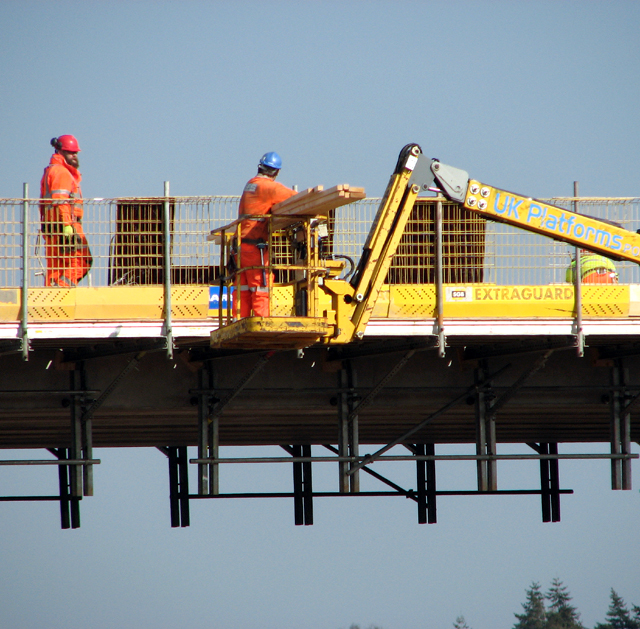Bats and construction

|
| This pedestrian bridge creates a footpath over the Broadland Northway and carries a hedgerow as a foraging route for bats. |
Contents |
[edit] Introduction
In the United Kingdom, there are 18 different species of bats. They live in a variety of environments across the UK and their breeding sites and resting places are protected by law.
[edit] Habitats and lifecycle
In order to survive, bats require water and insects to eat, hunting areas (foraging habitat), places to hibernate, sleep and raise young (roosts). They also require routes between these different locations (commuting routes).
[edit] Roosts
Bats require a variety of roosting habitats depending on the time of year. In the summer, female bats require a maternity roost to raise young, while in winter, hibernation roosts are required by all bats.
Roost sites vary and can include:
[edit] Foraging and commuting habitat
All UK bats feed on insects and so foraging habitats include pastures, woodlands or water. In order to navigate between these areas, bats use echolocation to navigate along hedgerows, woodland edges, treelines and watercourses.
[edit] Hibernation
Bats spend the winter hibernating, starting in October/November and typically emerging in March/April. The breeding season begins in June and continues over the summer.
[edit] Protection
Due to the decline of bat populations, it is illegal to:
- Capture, kill, disturb or injure bats (either deliberately or by not taking enough care).
- Damage or destroy their resting or breeding places.
- Obstruct access to their resting or sheltering places.
- Possess, sell, control or transport live or dead bats, or parts of them.
Any such offence could result in a prison sentence of up to 6 months and an unlimited fine for each offence together with the seizure of wealth gained by committing the offence and equipment used to cause the offence e.g. plant, machinery, vehicles etc.
[edit] Works that could affect bats
There are a range of situations in which bats could be present and affected by construction works:
- Renovation works to an existing building.
- Demolition of a building.
- Pruning or cutting down a tree.
- Repairing or replacing a roof on a house.
- Repointing brickwork.
- Works to lofts including insulation or conversions.
- Removing commuting habitats such as hedgerows or watercourses.
- Treating timber.
- Installation of wind turbines.
[edit] Bats and development proposals
If it is considered that bats could be affected by a development, surveys by an ecologist may be necessary.
[edit] Survey methods
There are a variety of survey methods that are appropriate for different structures at different times of year, including:
- Visual inspections.
- Surveys using bat detectors.
- Netting and harp trapping.
- Radio-tracking.
[edit] Visual inspections
Visual inspections might be appropriate for buildings, structures or trees. For buildings, this could include a combination of an internal inspection of roof voids or loft spaces, and an external inspection for potential entry points. It is possible for inspections to be undertaken at any time of year.
If it is not possible to determine whether a roost is present from an inspection, further bat detector surveys are likely to be required. If evidence of bats is confirmed during the inspection, it is likely that further detector surveys would be required to inform licensing requirements.
[edit] Bat detector surveys
Bat detector surveys can only be undertaken during the bat active season which is typically between May and September. During that time, several surveys are usually required at dawn or dusk. The surveys will last at least 2 hours.
[edit] Mitigation and licensing
If bats are found to be present and are considered likely to be affected by proposals, it may be necessary to obtain a protected species mitigation licence from Natural England, Natural Resources Wales or Scottish Natural Heritage in advance of works taking place. As part of the licence, a mitigation strategy will be required which will detail how impacts on bats and their habitats will be avoided or minimised wherever possible.
Mitigation measures may include:
- Altering work methods or timing to avoid bats.
- Creating or improving roosts.
- Creating or improving foraging or commuting habitat.
- Monitoring the roost sites after development.
[edit] Alternative meaning
Short Guide: Traditional Scottish Brickwork, published, on 1 March 2014 by Historic Environment Scotland, defines a bat as: ‘A broken section of brick, larger than a quarter brick, often used in Scottish brickwork as an alternative to a closer.’
[edit] Related articles on Designing Buildings
- Biodiversity offsetting.
- Ecological Impact Assessment.
- Ecological survey.
- Ecologist.
- Eco-Management and Audit Scheme.
- Environmental impact assessment.
- Environmental plan.
- Environmental policy.
- Great crested newt.
- Hop-overs.
- Japanese knotweed.
- National nature reserves.
- Natural England.
- Preliminary ecological appraisal.
- Protected species
- Protected species licence.
- Sustainability.
- Tree preservation order.
[edit] External references
Surrey Hills Directory
[edit] Planning
Building Design in the Surrey Hills
[edit] Highways
Conserving and Enhancing Country Lanes in the Surrey Hills AONB
[edit] Biodiversity & Landscape
Landscapes Review: National Parks & AONBs 2019
Light Pollution - Threat to Migrating Birds
Making Local Nature Recovery Strategies deliver
[edit] Health & Wellbeing
Nature and Wellbeing: The Evidence
How nature can be used to improve wellbeing







